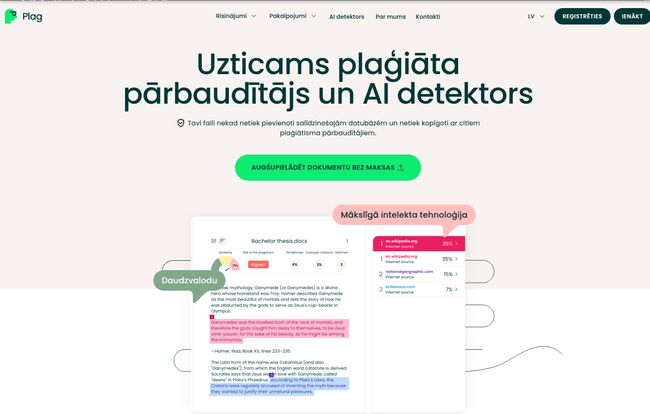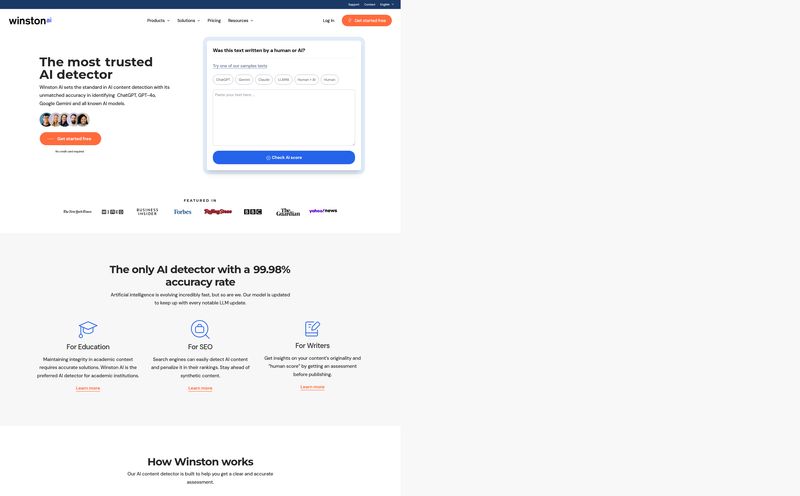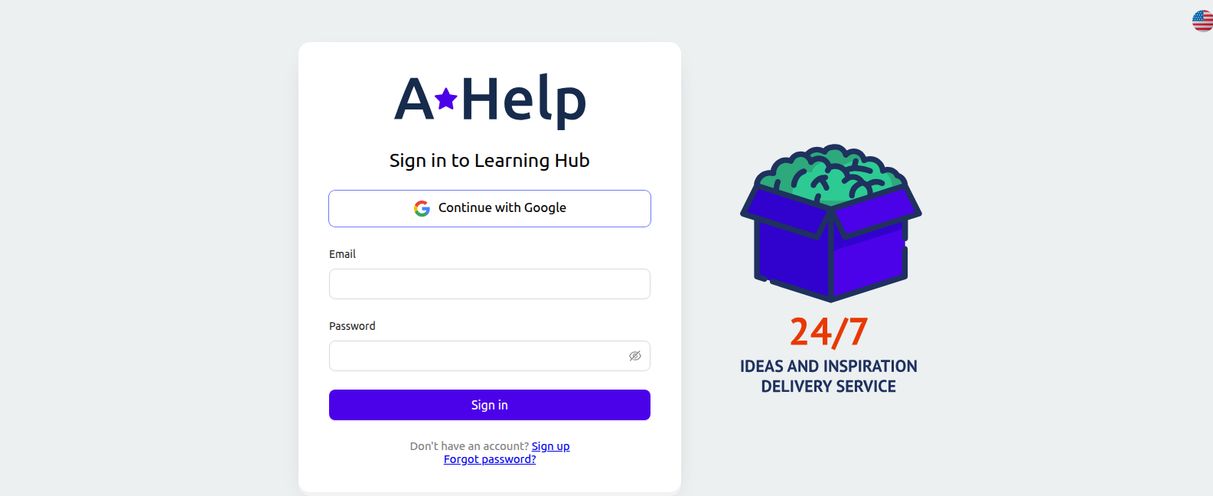It’s a jungle out there. A content jungle, specifically. And in this jungle, originality is king. But let's be real, with the sheer volume of information flying around and the rise of shockingly capable AI writers, how do you even know what's original anymore? I've been in the SEO game for years, and I've seen it all—from blatant copy-paste jobs to sophisticated AI-spun articles that almost pass the sniff test.
A few months back, I was reviewing a guest post. It felt… off. The tone was right, the keywords were there, but it lacked a certain spark. A human spark. On a whim, I ran it through an AI detector and—bingo. 85% likely to be AI-generated. That was a wake-up call. We're not just fighting old-school plagiarism anymore; we're in a whole new ballgame.
That’s what led me down the rabbit hole of tools like Plag. You’ve probably seen it pop up. It bills itself as an online plagiarism checker and AI detector for students and educators, but as a content pro, my interest was definitely piqued. Is it just another Turnitin clone, or is there something more under the hood? I decided to take it for a spin.
What Exactly is Plag Anyway?
At its core, Plag is a tool designed to be a guardian of academic and creative integrity. It’s a two-headed beast, really. On one side, you have a powerful plagiarism checker that scans your document against a colossal database of web pages and, crucially, scientific articles. On the other side, you have a modern AI detector built to sniff out text generated by models like GPT.
What caught my eye immediately was its global reach. The platform supports an insane 129 languages. That’s not just a footnote; it’s a game-changer for international institutions and multilingual creators. It shows they're thinking bigger than just the English-speaking world, which is refreshing. It’s a tool with a global perspective, even if its homepage has a Latvian (.lv) domain.

Visit Plag
The Features That Actually Matter
Any tool can throw a bunch of features on a pricing page. But which ones actually make a difference in your workflow? After playing around with Plag, a few things really stood out.
Beyond Simple Copy-Paste Checking
Let's start with the bread and butter: plagiarism detection. We've had these tools for ages, but Plag’s approach feels a bit more robust. The inclusion of a massive scientific article database is a huge deal for anyone in academia. It means a student’s paper isn't just checked against Wikipedia and some random blogs; it's cross-referenced with actual scholarly work. The similarity reports are incredibly detailed, giving you a percentage score and direct links to the source material. No more vague “this might be copied” warnings. It’s more like a content x-ray, showing you exactly where the borrowed bits are.
Tackling the AI Elephant in the Room
Here’s the part that really matters for people like me. The AI detector. We're in the midst of an arms race between AI content generation and detection. While I'm a firm believer that no AI detector is a perfect, infallible magic bullet (and you should be wary of any tool that claims it is), having a solid one in your arsenal is becoming non-negotiable. I ran a few of my own AI-assisted drafts through it, and the results were pretty insightful. It’s great for flagging passages that sound too robotic or formulaic, which is a great prompt for a human writer to go back and inject more personality. Think of it less as a cop and more as a helpful editor nudging you to be more human.
Speaking Your Language (Literally)
I have to come back to the multi-language support because it's just that impressive. For universities with international students or companies creating content for global markets, this is a massive plus. The ability to maintain academic integrity or brand voice consistency across dozens of languages from a single platform is a serious competitive advantage.
Let's Talk Money: The Pricing Breakdown
Alright, the all-important question: what’s this going to cost me? Plag’s pricing structure is… interesting. It's a mix-and-match model that tries to cater to different users, from the broke student to the bustling institution.
| Plan Type | Cost | What You Get | Best For |
|---|---|---|---|
| Free Plagiarism Check | €0.00 | 1 document check | A one-time emergency check. |
| Pay As You Go | From €1.50 / document | Per-document checks | Occasional users who don't need a subscription. |
| Document Packages | €29.99 for 3 docs | Bulk credits at a discount | Students with multiple papers per semester. |
| Premium AI Detection | €9.95 / month | Unlimited AI text checks | Bloggers, SEOs, and educators constantly vetting content. |
The free check is a nice gesture. It's perfect for that one time you have a panic attack the night before a deadline. But for regular use, you’ll need to open your wallet. The Pay As You Go model is fair, but the real value for content creators is the Premium AI Detection subscription. At under ten Euros a month for unlimited checks, it feels like a very reasonable investment for anyone who publishes or reviews content regularly. It’s cheaper than a couple of fancy coffees and could save you from a Google penalty or an embarrassing client call. That seems like a pretty good trade to me.
The Good, The Bad, and The Realistic
No tool is perfect. After spending some quality time with Plag, here's my honest, no-fluff take.
What I Genuinely Like
The user interface is clean and straightforward. You don't need a PhD to figure out how to upload a document and get a report. I’m a big fan of the detailed similarity reports with the source links—it gives the tool a sense of authority and transparency. And a huge kudos for offering free checks to teachers. It’s a smart, goodwill-building move that shows they understand their core academic audience.
Where It Could Be Better
My main gripe, and it's a common one for students, is the limitation on the free tier. One check is enough to get a taste, but it quickly pushes you towards a paid plan. Also, while its AI detector is good, we have to be realistic. The technology is constantly evolving. What works today might be less effective against the next generation of AI models tomorrow. It’s a tool for guidance, not a final verdict set in stone. Dont let any tool make the final decision for you.
So, Who Is Plag Actually For?
This isn't a one-size-fits-all solution. Its utility really depends on who you are.
- For Students: It’s a powerful safety net. Running your final paper through Plag before submission is a smart move to catch accidental plagiarism or fix citations. The pay-as-you-go model makes sense here.
- For Educators and Academics: This is a slam dunk. The combination of plagiarism checking against scientific journals and the AI detector makes it an essential tool for maintaining classroom integrity. The free plan for teachers is the cherry on top.
- For Bloggers, SEOs, and Content Managers: This is my camp. I see the AI detection subscription as the main draw. It’s a valuable step in the editing process, especially when working with freelance writers or using AI for brainstorming. It helps ensure the final product is original, authentic, and less likely to be flagged by things like Google’s Helpful Content systems.
Frequently Asked Questions About Plag
- How accurate is Plag's AI detection?
- It's quite good, but like all AI detectors, it's not 100% infallible. The technology is in a constant cat-and-mouse game with AI writers. Use it as a strong signal and a guide for manual review, not as an absolute judge.
- Is Plag better than Turnitin?
- They serve similar purposes but have different strengths. Turnitin is deeply integrated into many academic institutions. Plag offers a more flexible, public-facing platform with a very accessible AI detection subscription and a broader language base, making it great for individuals and smaller organizations.
- Can Plag detect sophisticated paraphrasing?
- Yes, its similarity-checking algorithms are designed for this. It looks for structural and semantic similarities, not just direct word-for-word copies. This is where it outshines more basic, free checkers.
- Is it safe to upload my documents to Plag?
- From what I've seen, they take privacy seriously. According to their policies, they don't share your documents. However, as with any online service, it's always a good habit to review the latest privacy policy and terms of service before uploading sensitive material.
- What’s the real difference between the free and paid versions?
- Volume. The free version is essentially a single-use trial to see how the plagiarism checker works. To do any meaningful or regular work, whether it's checking multiple papers or constantly vetting content for AI, you'll need one of their paid plans.
The Final Word on Plag
So, is Plag the ultimate gatekeeper of originality? It's a damn good one. It's a comprehensive, well-designed tool that addresses the two biggest content challenges of our time: plagiarism and AI generation. It’s not magic, and it requires a human with good judgment to interpret the results.
For the price, especially the AI detection subscription, it offers tremendous peace of mind. In an era where trust and authenticity are the most valuable currencies online, investing in a tool that helps you protect them feels less like an expense and more like a necessity. It’s a solid addition to any serious writer’s or educator’s toolkit.
Reference and Sources
- Plag Official Pricing Page: https://www.plag.lv/cenas



